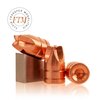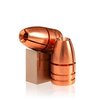In that case I can share what I have with everyone.
Please be aware that this load produces fairly high pressure and would not be safe in a tradition conversion revolvers or any original 38 Short Colt.
My current competition load is:
Brass: Remington or Starline
Primer: Federal Small Pistol
Bullet: IBEJIHEADS 160gr RN coated lead, sized .358
OAL: 1.19 inch
Powder: Hodgdon Titegroup
Charge: 3.23 gr (that is the average of 10 drops from an XS charge bar in my Dillon XL 650)
Average Velocity: 871 fps (fired from a 5-inch 627)
PF: 139.4 This is well over Minor Power Factor I needed for USPSA but much below this velocity accuracy got pretty bad so I kept the velocity up.
Quickload predicts this load very accurately after updating the 38 Short Colt entry that was very incorrect. QL is predicting 867 fps with a peak pressure of 26,400 psi for the above load. I have not confirmed that pressure with real measurements but it should give you an idea of the pressures we are dealing with.
A finely crafted example of my reloading
View attachment 918299







